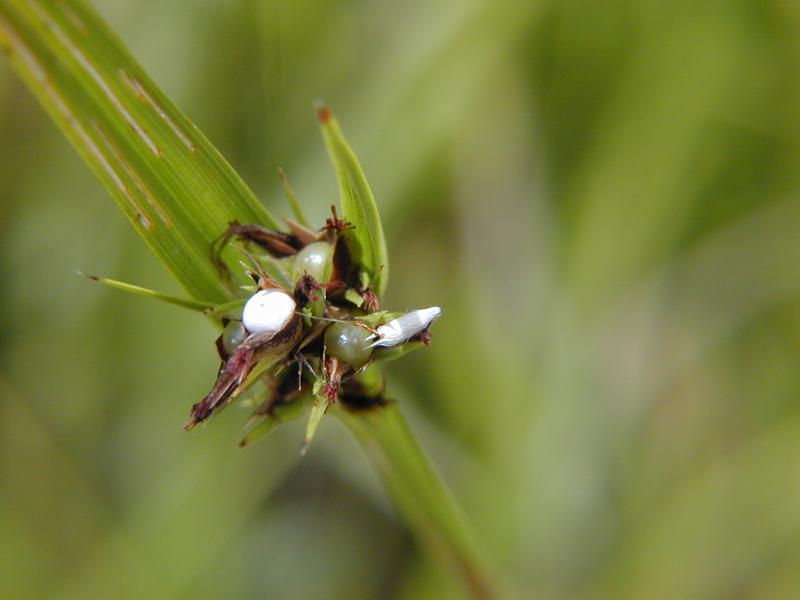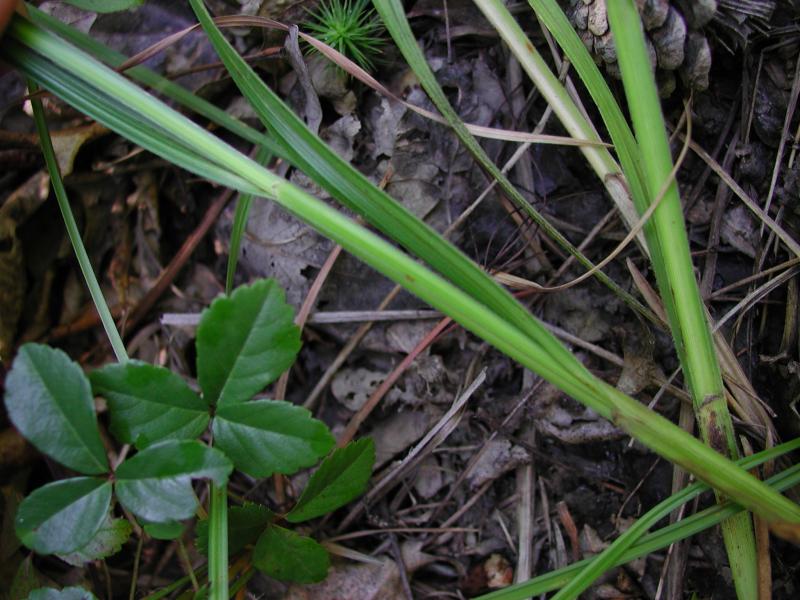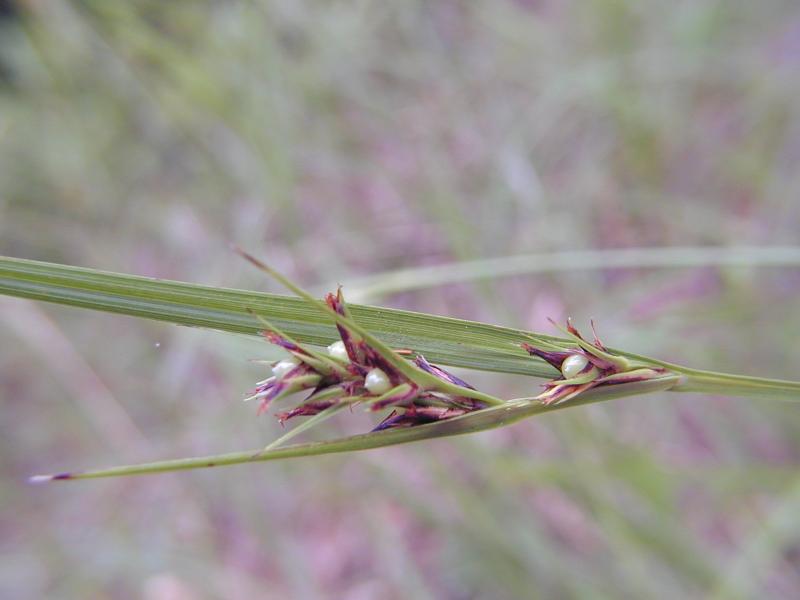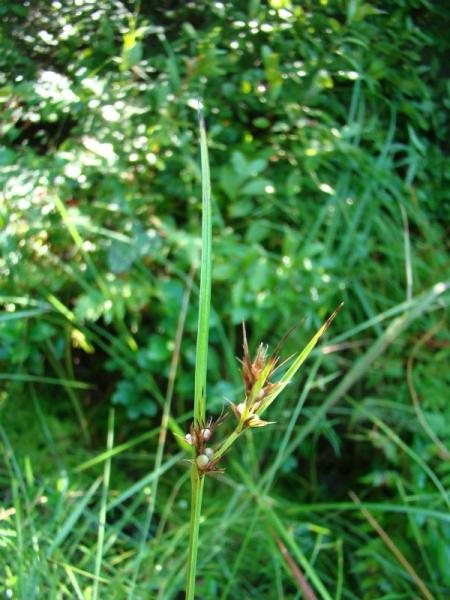Whip Nut Sedge
Scleria triglomerata Michx.
- Class
- Monocotyledoneae (Monocots)
- Family
- Cyperaceae (Sedge Family)
- State Protection
- Endangered
Listed as Endangered by New York State: in imminent danger of extirpation in New York. For animals, taking, importation, transportation, or possession is prohibited, except under license or permit. For plants, removal or damage without the consent of the landowner is prohibited.
- Federal Protection
- Not Listed
- State Conservation Status Rank
- S1
Critically Imperiled in New York - Especially vulnerable to disappearing from New York due to extreme rarity or other factors; typically 5 or fewer populations or locations in New York, very few individuals, very restricted range, very few remaining acres (or miles of stream), and/or very steep declines.
- Global Conservation Status Rank
- G5
Secure globally - Common in the world; widespread and abundant (but may be rare in some parts of its range).
Summary
Did you know?
The plants that occur in the ice meadows of the Hudson River in Warrensburg are at the northeastern limit for this species in the United States. Their nearest population in New York is in Massapequa on Long Island.
State Ranking Justification
There are nine existing populations, but only one of them has over 100 plants and most of them are not in protected areas. There are 13 historical records.
Short-term Trends
Short-term trends seem to be stable, although it is difficult to assess whether plants still exist in the seed bank if they have not been seen in recent years.
Long-term Trends
This sedge has always been rare in New York and the number of existing populations has remained about the same over time, and is expected to continue this way into the foreseeable future.
Conservation and Management
Threats
The lack of disturbance may be hindering their reproduction on one hand, but too much disturbance by improper timing of roadside management, use of herbicides for roadside managment or control of invasives, or destruction by ATVs may also reduce numbers of plants.
Conservation Strategies and Management Practices
This species needs disturbance to reduce competition from woody plants or more aggressive herbaceous plants, but too much direct disturbance to the plants will reduce or eliminate the population. Its habitat could be disturbed in the non-growing season to open it up for seed germination and colonization, but direct disturbance should be prevented during the growing season.
Research Needs
More research is needed into the seed banking ability of this plant in New York, and what kind of disturbance is necessary for optimal growth.
Habitat
Habitat
In New York, Scleria triglomerata has most often been at wet edges within dry, sandy sites. It is known from roadsides within pine barrens, sand plains, and oak woods bordering salt marshes. There is also one population in ice meadows along the Hudson River in the Adirondacks (New York Natural Heritage Program 2011). Dark woods to open, moist pinelands, meadows, swales, prairies, and savannas (FNA 2002). Moist or dry sandy soils and pine-barrens (Gleason and Cronquist 1991).
Associated Ecological Communities
- Coastal plain pond shore
(guide)
The gently sloping shore of a coastal plain pond with seasonally and annually fluctuating water levels. Plants growing on the pond shore vary with water levels. In dry years when water levels are low there is often a dense growth of annual sedges, grasses, and herbs. Submerged and floating-leaved aquatic plants, such as fragrant waterlily and pondweeds, may become "stranded" on the exposed shore. In wet years when the water level is high only a few emergents and floating-leaved aquatics may be noticeable. T
- Mowed roadside/pathway*
A narrow strip of mowed vegetation along the side of a road, or a mowed pathway through taller vegetation (e.g., meadows, old fields, woodlands, forests), or along utility right-of-way corridors (e.g., power lines, telephone lines, gas pipelines). The vegetation in these mowed strips and paths may be dominated by grasses, sedges, and rushes; or it may be dominated by forbs, vines, and low shrubs that can tolerate infrequent mowing.
- Pine barrens vernal pond*
(guide)
A seasonally fluctuating pond and its associated wetlands that typically occurs in pine barrens. The water is intermittent, usually a pond in the spring but sometimes losing water through the summer to become a mostly vegetated wetland at the end of the summer. These ponds and wetlands may be small.
- Pitch pine-blueberry peat swamp*
(guide)
A swamp that occurs in shallow depressions in sand plains where peat has accumulated over a poorly drained sandy soil. This soil has a horizon cemented by iron oxide; the cemented horizon impedes drainage and causes seasonal flooding. The dominant tree is pitch pine. Gray birch and red maple are present at a low density. The canopy is open, with about 50 to 60 percent cover.
- Pitch pine-oak forest*
(guide)
A mixed forest that typically occurs on well-drained, sandy soils of glacial outwash plains or moraines; it also occurs on thin, rocky soils of ridgetops. The dominant trees are pitch pine mixed with one or more of the following oaks: scarlet oak, white oak, red oak, or black oak.
- Successional northern sandplain grassland*
(guide)
A meadow community that occurs on open sandplains that have been cleared and plowed (for farming or development), and then abandoned. This community is usually dominated by low, dry turf of sedges and grasses less than 30 cm (12 inches) tall, and include patches of open sand and patches of soil covered with mosses and lichens.
* probable association but not confirmed.
Associated Species
- Andropogon virginicus
- Carex vestita (velvet sedge)
- Desmodium
- Gaylussacia baccata (black huckleberry)
- Lechea racemulosa (oblong-fruited pinweed)
- Lespedeza
- Pteridium aquilinum
- Quercus velutina (black oak)
- Schizachyrium scoparium
- Vaccinium corymbosum (highbush blueberry)
Range
New York State Distribution
This small herb is currently known from Nassau and Suffolk counties on Long Island and from Warren County. There are historical records from the New York City area, the Pine Bush in Albany County, and Rome Sand Plains in Oneida County.
Global Distribution
It grows in the Eastern United States from Minnesota south to Eastern Texas and east to Florida, New York, and Southern New England.
Identification Comments
General Description
Scleria is a genus of sedge with 3-angled culms, dimorphic spikelets, and conspicuous white achenes. Whip nutrush is an erect hairless plant that grows 4-10 dm tall from clustered, knotty rhizomes. The leaves are linear, 3-9 mm wide, rigid, and shorter than the stems. There are terminal and axillary clusters of spikelets each with 3-10 spikelets. The lateral clusters are on erect peduncles which become more drooping when growing in the shade. The bracts below the clusters are leaf-like and lanceolate, 3-11 cm long and long pointed. The spikelet scales are brown with mid-ribs that extend into a point beyond the top of the scale. The achenes are smooth white or sometimes grayish brown with dark horizontal bands. They are rounded, 2-3 mm in diameter, with a disk at the base that is slightly 3-angled and covered with whitish or brownish papillae (FNA 2002).
Best Life Stage for Proper Identification
Whip nutrush is best identified when in fruit.
Similar Species
The other five species of Scleria in New York all occur within the range of Scleria triglomerata and are best differentiated in fruit. Scleria pauciflora var. pauciflora and var. caroliniana are hairy and have six tubercles at the base of the achene. Scleria minor is most closely related but has leaves that are only 1.2.5 mm wide and achenes that are 1.5-2 mm in diameter. Scleria reticularis and Scleria mühlenbergii have rough achenes with 3 oblong lobes at the base and their flower clusters are more open-paniculate with visible branches. Scleria verticillata has no disk or lobes at the base of the achene and the plants are annual and lacking rhizomes (FNA 2002).
Best Time to See
Whip nutrush is easiest to see and identify when it is in fruit, from late June early October.
- Fruiting
The time of year you would expect to find Whip Nut Sedge fruiting in New York.
Whip Nut Sedge Images
Images of Similar Species
Taxonomy
Whip Nut Sedge
Scleria triglomerata Michx.
- Kingdom Plantae
- Phylum Anthophyta
- Class Monocotyledoneae
(Monocots)
- Order Cyperales
- Family Cyperaceae (Sedge Family)
- Order Cyperales
- Class Monocotyledoneae
(Monocots)
- Phylum Anthophyta
Additional Common Names
- Nutrush
- Whipgrass
Synonyms
- Scleria nitida Muhl. ex Willd.
- Scleria triglomerata var. gracilis Britt.
Additional Resources
Best Identification Reference
Flora of North America Editorial Committee. 2002. Flora of North America, North of Mexico. Volume 23. Magnoliophyta: Commelinidae (in part): Cyperaceae. Oxford University Press, New York. 608 pp.
Other References
Crow, Garrett E. and C. Barre Hellquist. 2000. Aquatic and wetland plants of northeastern North America: A revised and enlarged edition or Norman C. Fassett's a manual of aquatic plants. Volume two angiosperms: Monocotyledons. The University of Wisconsin Press. Madison, Wisconsin. 456 pp.
Fairey, J. E., III. 1967. The genus Scleria in the southeastern United States. Castanea 32(1):37-71.
Fernald, M. L. 1950. Gray's manual of botany. 8th edition. Corrected printing (1970). D. Van Nostrand Company, New York. 1632 pp.
Gleason, H.A., and A. Cronquist. 1991. Manual of vascular plants of northeastern United States and adjacent Canada. New York Botanical Garden, Bronx, New York. 910 pp.
Gleason, Henry A. and A. Cronquist. 1991. Manual of Vascular Plants of Northeastern United States and Adjacent Canada. The New York Botanical Garden, Bronx, New York. 910 pp.
Godfrey, R.K., and J.W. Wooten. 1981. Aquatic and wetland plants of southeastern United States: Dicotyledons. Univ. Georgia Press, Athens. 933 pp.
Holmgren, Noel. 1998. The Illustrated Companion to Gleason and Cronquist's Manual. Illustrations of the Vascular Plants of Northeastern United States and Adjacent Canada. The New York Botanical Garden, Bronx, New York.
Hough, M.Y. 1983. New Jersey wild plants. Harmony Press, Harmony, NJ. 414 pp.
McCance, R.M., Jr., and J.F. Burns, eds. 1984. Ohio endangered and threatened vascular plants: Abstracts of state-listed taxa. Division Natural Areas and Preserves, Ohio Dept. Natural Resources, Columbus. 635 pp.
Mitchell, Richard S. and Gordon C. Tucker. 1997. Revised Checklist of New York State Plants. Contributions to a Flora of New York State. Checklist IV. Bulletin No. 490. New York State Museum. Albany, NY. 400 pp.
New York Natural Heritage Program. 2010. Biotics database. New York Natural Heritage Program. New York State Department of Environmental Conservation. Albany, NY.
New York Natural Heritage Program. 2024. New York Natural Heritage Program Databases. Albany, NY.
Radford, A.E., H.E. Ahles, and C.R. Bell. 1968. Manual of the vascular flora of the Carolinas. Univ. North Carolina Press, Chapel Hill, NC. 1183 pp.
Read, R.H. 1976. Endangered and threatened vascular plants of Wisconsin. Technical Bull. No. 92, Scientific Areas Preservation Council, Dept. Natural Resources, Madison, WI. 58 pp.
Rhoads, A.F., and W.M. Klein, Jr. 1993. The vascular flora of Pennsylvania: Annotated checklist and atlas. American Philosophical Society, Philadelphia, PA. 636 pp.
Ridley, H.N. 1930. The dispersal of plants throughout the world. L. Reeve & Co., Ltd., Ashford, Kent, United Kingdom. 744 pp.
Voss, E.G. 1972. Michigan flora: A guide to the identification and occurrence of the native and naturalized seed-plants of the state. Part I. Gymnosperms and monocots. Cranbrook Institute of Science and Univ. Michigan Herbarium. Ann Arbor. 488 pp.
Weldy, T. and D. Werier. 2010. New York flora atlas. [S.M. Landry, K.N. Campbell, and L.D. Mabe (original application development), Florida Center for Community Design and Research http://www.fccdr.usf.edu/. University of South Florida http://www.usf.edu/]. New York Flora Association http://newyork.plantatlas.usf.edu/, Albany, New York
Links
About This Guide
Information for this guide was last updated on: August 9, 2011
Please cite this page as:
New York Natural Heritage Program. 2024.
Online Conservation Guide for
Scleria triglomerata.
Available from: https://guides.nynhp.org/whip-nut-sedge/.
Accessed July 26, 2024.





